WORLD CLASS COACHING
Club Curriculum U13/14 Season
By Tony Englund
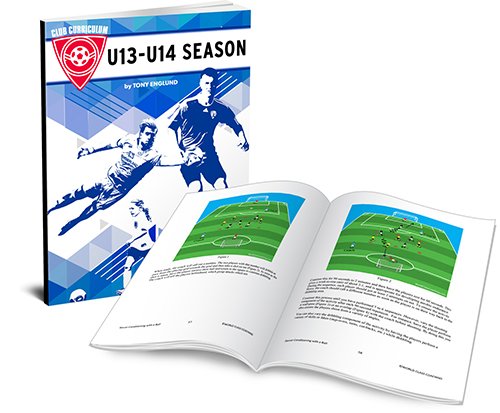
TABLE OF CONTENTS
Part Two
DEFENDING SESSIONS
Training Session #9: Defending Footwork
Introduction: Much of good defending is in the approach and ability to control the attacker’s speed, options and movement. This session utilizes environments borrowed from national and high-level club team training to train defenders to focus on the quality and speed of their footwork in closing down.
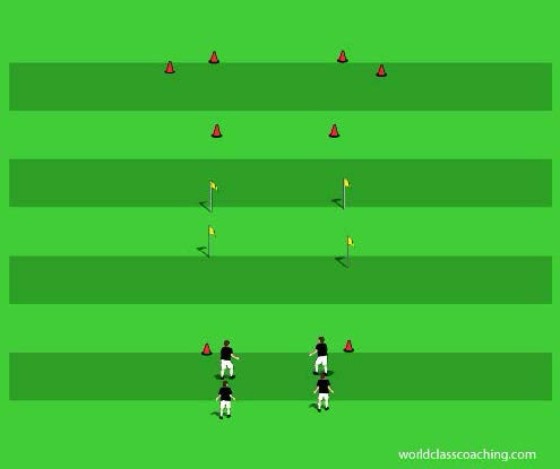
Shadow Footwork - 10x20 yard lane.
Players form two lines at one end of the lane. To warm up, they complete following sequence of runs, jogging to the flag, then performing an active stretching exercise and then jogging from the second flag to the end of the lane before jogging back to the start.
• jog/high knees/jog
• jog/high heels/jog
• jog/shuffle left/jog
• jog/shuffle right/jog
• jog/backpedal/jog
• jog/sprint/jog
Progression:
• players in the far line step in front of the near line and jockey the player from the near line, who zig-zags forward through the lane. Players change lines after each run.
• finally, players from the far line jockey players from the near line and as the attacker nears the end of the lane, she sprints through one of the gates. The defender attempts to beat her through the gate.
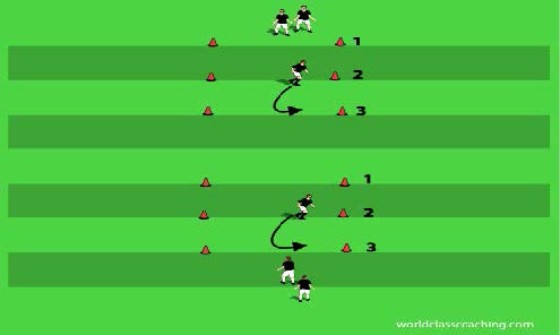
Numbered Cones Footwork - 10x10 yard areas
Arrange cones as shown in the diagram. Form lines at the ends of the cone lines. The first two players step in and face the numbered cones at the bottom of the grid. They get into jockeying position and try to respond as quickly as possible to the following commands:
• 1: Move to jockey the #1 cone.
• 2: Move to jockey the #2 cone.
• 3: Move to jockey the #3 cone.
• turn: Turn around and jockey the same number on the other side.
• switch: Move to the other set of cones.
• recover: Run around the other set of cones and then return to current cone.
Each pair of players works for 30 seconds before the next pair takes over.
1v1 continuous – no tackling - 10x10 yard grids
Play 1v1 duels in a 10x10 yard grid. The defender initiates the duel by passing to the attacker and closing down. The defender is not allowed to tackle and must attempt to delay and drive the attacker out of the grid through physical pressure and good footwork. Focus on passing the ball to a corner and denying the attacker space and options. The attackers attempt to dribble over the defender’s endline. Play until the ball leaves the grid. Players change ends after each duel.
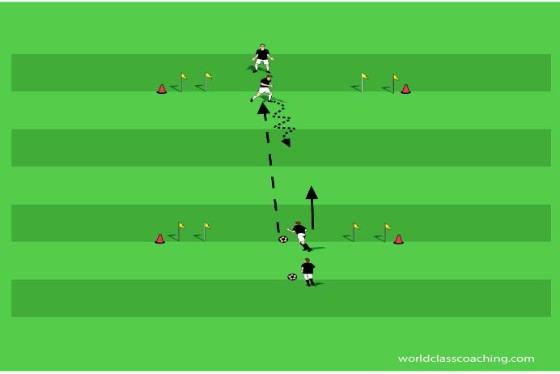
1v1 to 4 goals - 15x15 yard grids
Organize players in groups of 4-6 per grid, with a ball supply at one end of the grid. Put an equal number of players in lines at each end of the grid. This is a simple, but very effective training environment designed to improve one vs. one play on both sides of the ball. Explain that the goal of the exercise is to dribble the ball through either of the the opponents’ flag goals.
The presence of two goals encourages attackers to change directions. Play is live as long as the ball remains inside the grid. The first player on the end where the balls are organized initiates re-starts by passing to the first player on the other end of the grid. These duels compel the defending player to deal with an attacker with multiple options, and the defender will need to work to get her feet into defending position every time the attacker changes directions.
8v8 Scrimmage - ½ field
Play an 8v8 scrimmage on ½ field. For the first 10 minutes of the scrimmage, the coach calls out names of random members of the defending team. Any player whose name is called must run and touch the nearest field line (touch or end line or circle or parts of the box) before returning to play. This requirement compels the other defenders to scramble to deal with the holes in their defense, and the running defenders in essence are completing recovery runs and then getting settled to defend if their team has not yet won the ball, all of which conditions them to defend better 1v1.
Training Session #10: Advanced Individual Defending
Introduction: This session introduces a number of very important and useful concepts for advanced individual defending, from fake tackles to dealing with attackers in a variety of situations. Explain to the players beforehand that this session assumes that basic jockeying and tackling are already part of the players’ understanding and that these tools are designed to allow the players the opportunity to be successful against quality attackers.
Footwork: Advanced concepts - 25x25 yard grid
In pairs, the players work back and forth across the area rehearsing advanced individual defending concepts as outlined below. Each player should adopt the attacker’s role twice and defend twice. There is no tackling in this exercise and the attacker should focus on changes of direction and speed, but not trying to get in behind the defender, except where noted.
• close down and jockey. The defender starts 10 yards ahead of the attacker and initiates the run with a pass to the attacker’s feet. The defender closes down with a bent run (show the ball to one side) and works to stay goal side by jockeying the attacker across the grid.
• fake tackle. One of the best ways for a defender to keep the attention of the attacker focused on the ball (rather than her options) is to fake tackle. This simply involves a hard step forward out of the jockeying position. The defender must concern herself with her timing, as the attacker can win the duel if she is able to play in behind when the defender steps. The best time to do this is when the ball is off of the attacker’s foot. The defender then recovers (in a game she may choose to follow up with a tackle).
• cut out runs. Here the attacker starts with the ball and standing next to the attacker. The attacker touches the ball ahead and the defender steps immediately between the ball and the attacker and then closes to step on the ball. Players change roles with each sequence. This is a critical concept for the defender, as she must recognize that at some point the attacker will play in behind and the defender must move quickly to cut off the run while playing the ball.
• getting shoulder ahead. Play without a ball. The two players start shoulder-to-shoulder. One player hollers, “go!” and the two race for the opposite endline. In this case, they should be in shoulder contact throughout their runs and both players should be trying to get shoulder ahead in the direction they are running. The player who is shoulder-ahead in a duel situation will most often win the ball. Another tip in this regard is to encourage players to ‘swim’ as they run in contact with another player. The idea here is that the swimming motion with the arms will help to pull the player forward while inhibiting the ability of the opponent to do the same.
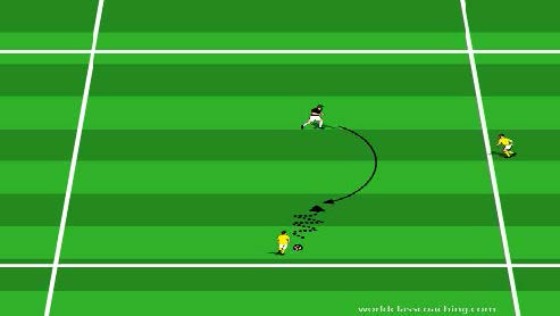
1v1+1 - 10x15 yard grids
Groups of 4-5 players at each grid. Locate a ball supply on one end of the grid. The defender begins the duel by passing to the attacker at the far end of the grid. The attacker can try to beat the defender on the dribble or use the bumper (limited to one touch, but can move up and down the side of the grid) to create a 1-2 to get in behind the defender. This environment compels the defender to read the situation and drive the attacker away from the support player, as shown above. The defender also learns to recover very quickly if the ball is played in to the support player, thus protecting the space in behind her (below).
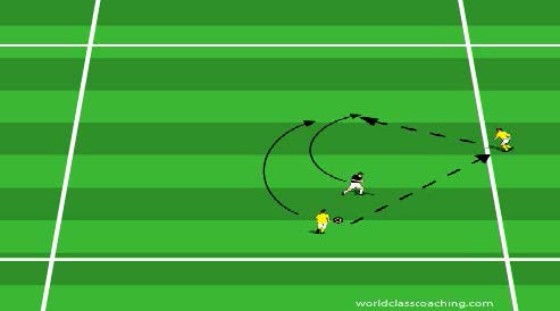
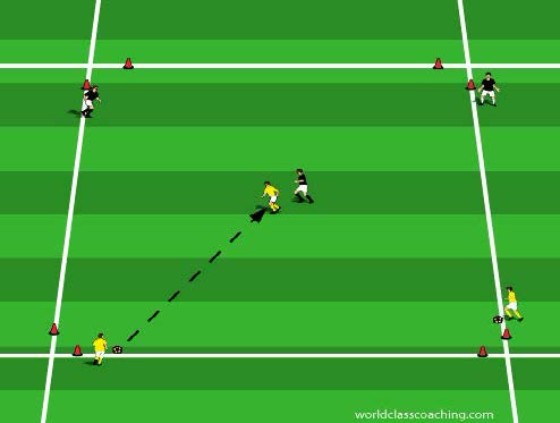
1v1 with attacker facing away from goal - 15 x 15 yard grids with 4 corner goals.
Groups of 2 players at each goal. Locate a ball supply at two corners (not opposite). Duels run between players from diagonally-opposed goals. In this case, the defender and attacker begin at the middle of the grid, with the attacker shoulder on to the defender. Play is initiated by resting attacker, who passes the ball to the attacker’s back foot. Neither player can move before the attacker’s first touch, but then play is live and both players try to win the ball and play through their opponent’s goal. It is very important for defenders to be able to distinguish the attacker’s options based on their positioning. In this case, with the attacker facing away from the goal, here are some tips and considerations.
Priorities:
• deny ball (impossible here by design); deny turn; deny dribble; deny shot.
• get touch close: If the defender is too close, the attacker can spin off of the defender and get in behind; if the defender is too far away, the attacker can turn and face the defender, increasing her options. Touch close, as the term implies, means getting close enough to touch the player.
• eyes on one side, feet on the other. When the attacker is facing away from goal, the defender should put her feet on one side (left or right) and her head and eyes on the other. This helps balance the defender, and then the defender looks for the first touch forward as the moment to tackle.
• press an attacker whose first touch is backward. Many talented attackers will take a touch away in an effort to try to create space to turn. When the attacker does this, she cannot spin off, so the defender should get very tight to an attacker who is moving backward in pursuit of the ball.
4v4 games - 20x25 yard grids
Play 4v4 games to small cone goals. Players are only allowed to defend against one player (assign opponents) from the opposing team. This requirement will create numerous opportunities for duels with attackers facing toward and away from goal and defenders should be encouraged to utilize the techniques introduced above.
8v8 scrimmage - ½ field
Close with an 8v8 game without restrictions. Continue to emphasize good technique and decision-making on the defensive side of the ball in particular.
Training Session #11: Second Defender
Introduction: The second defender is the player closest to the first defender, who is the player nearest the ball for the defending team. This player’s role is to support and cover the first defender, and this session looks at building familiarity and discipline within the team regarding providing defense in depth in the game.
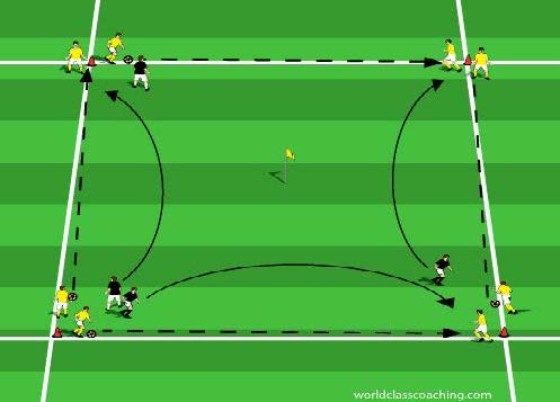
Defending footwork - 15x15 yard grid
Players work in groups of 3 inside a triangle formed by the coaching stick at the center of the grid and the cones on two corners. Two attackers stand near the cones and pass a ball back and forth between them (they hold the ball until the defender is in position and set). The defender, using the cone stick as a guide (as an attacking target), works back and forth between the attackers, working to get outside of the ball and screen the angle forward to the coaching stick (thus forcing the square pass). Quick footwork and the desire to force the ball away from critical space are very important to effective first-defending (the first defender is simply defender closest to the ball), particularly when the second defender is introduced in this session. Play for 30 seconds and then rotate the defenders.
Variations:
• the coach calls “next!” and the defenders (not the attackers) move one triangle clockwise and continue to defend. This variation forces the defender to change position and then get right to work containing the attackers again.
• the coach calls “cross!” and the defenders move to the opposite side of the grid and continue defending.
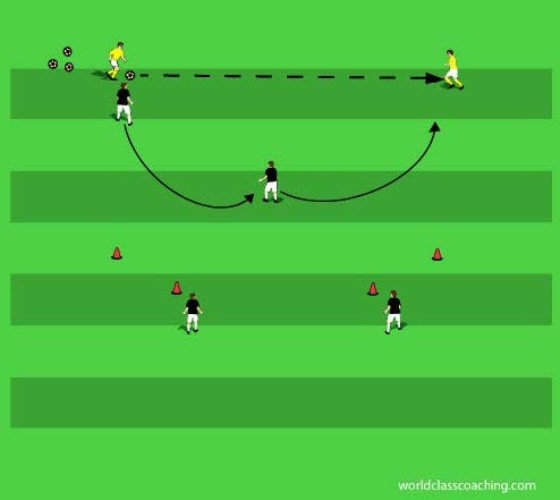
1st and 2nd defender interchange - 15x15 yard grid
Two attackers ping a ball back and forth at two cones at the top of the grid area. Two defenders, moving out of each of the goals at the other end, interchange first and second defender roles while closing the space between them and the attackers. The attackers are not looking to score, but rather continue to slowly pass the ball back-and-forth in place. The first defender (the defender on the ball side) needs to work forward, getting outside of the ball (to show the ball back toward her support) and also covering the goal on her side of the field.
The second defender gets into a covering position, which is to say that she gets behind the line of the first defender and about a corner flag pole length away from her. From this position in a game situation, the second defender would be in position to deny the attacker a run at goal if the first defender was beaten. Defenders continue to interchange roles as the ball is passed. Play for 30 seconds and then the defenders become the passers and play continues with a new set of defenders.
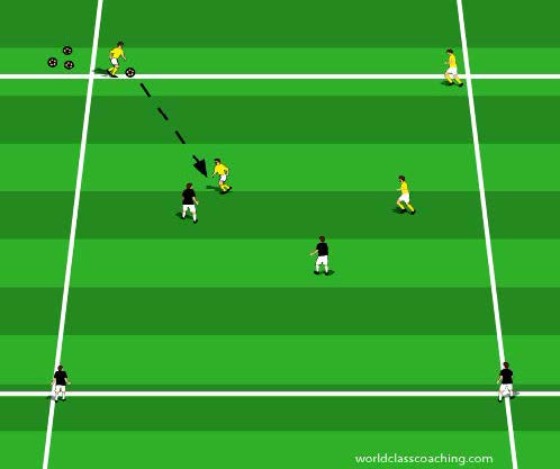
2v2 plus 4 - 15x25 yard grids
Play 2v2 plus 4. The game features 2v2 in the grid while two members of each team serve as targets at their opponents’ corner ends of the grid. The active players try to play in to either of the corner targets. When the corner targets receive the ball, they play in to their opponents and the game continues in the other direction. The active players cannot play back to the corner players fro support. This environment is ideal for training first and second defender roles. The space is tight enough for the defenders to be able to apply good pressure and the even numbers will create frequent interchanges between the two attackers and consequently the defenders will need to adjust their roles often as well.
8v8 Scrimmage - ½ field
Close the session with an 8v8 scrimmage. Deploy the teams in 2-4-2 formations and encourage them to pay attention to the first and second defender roles within their particular group (i.e. the two backs or any two neighboring midfielders).
Training Session#12: Training the Back Line
Introduction: This session introduces a progressive set of exercises the coach can use to develop understanding between players assigned to playing on the back line. This session assumes the team will be playing a in a ‘flat’ arrangement.
Shaping the group: Movement to confront an attack - ½ field
The back four move up the field together to confront each consecutive ball. At each ball, the players adopt a ready position and then hold while the coach makes adjustments to assure the group’s shape is appropriate.
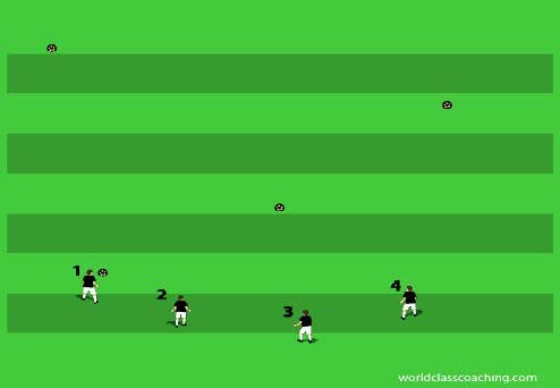
Coach:
• the general shape, as shown above, is that of a hook or the letter “J” when the ball is on either flank.
• the first defender (player 1) closes on the ball, using a bent run to channel the ball to a touch-line or toward defensive cover. The near-side center back, the second defender, provides close cover.
• note that the third defender from the ball (i.e. the far side center back, player 3) sets the depth of the line.
• the back-side defender (player 4) tucks in to protect the space outside of the neighboring center back (player 3)
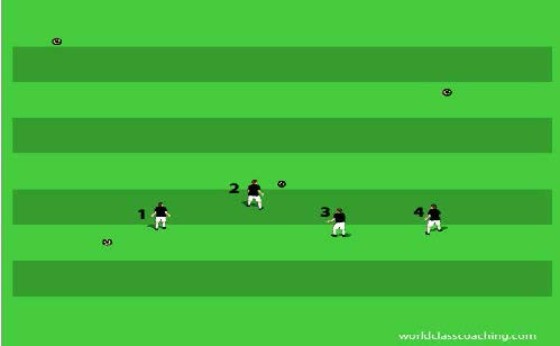
• when the ball is nearer the middle of the field, the shape is more of an “S,” situated on its side.
• here, defenders 1 and 3 cooperate to set the depth of the defense, while providing cover to the first defender (player 2).
• the back-side defender (player 4) tucks in again to protect the space outside of the center back (player 3).
• with every movement to a new ball, each of the players must look to the rest of the group, communicating and dressing their positions in unison with the group.
Considerations:
• tactical priorities of the team. Will the team show the ball to the flank or channel the ball inside? The coach must be ready to instruct the players as to their priorities and the team/system philosophy of play.
• area on the field (i.e. in the back third, the flank defenders likely show the ball outside, while in the front two-thirds the team’s defending strategy may call for the ball to be shown inside).
Progression:
• at the command of the coach, the group moves up one ball or back one ball. This movement compels the players to work together in pressing up and also recovery.
• two attackers ping the ball to one-another (and move about the field, giving new angles and distances) for the back line to adjust to.
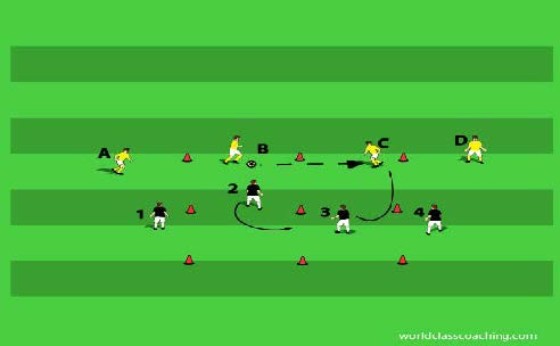
Adjustment under pressure: 4v4 zone play - 30x30 yard area
This exercise allows the back four to practice responding together to a group of attackers in a progressively live and functional environment. Players A-D begin play as stationary passers across the width of the grid. Defenders 1-4 adjust to each square pass, once again rehearsing smooth and quick movement to each movement of the ball. Allow no tackling for the first two minutes of play, giving the defensive block the opportunity to work through shadow movements.
Progression:
• live play. The defenders now attempt to win the ball, but are confined to their vertical zones unless multiple attackers enter an individual zone. If the defenders gain possession, they step on the ball and then return it to the attackers to restart play. The attackers simply aim to keep possession.
Coach:
• demonstrate how the group can deal with attacking overloads in individual zones. For example, if players A and B both attack (and attempt to overlap to play out player 1) into the zone occupied by player 1, player 2 moves into the zone in a covering position and either releases player 1 to track B’s run (and then marks player A) or tracks B’s run, allowing 1 to continue to press A, depending on the situation.
Progression:
• remove the vertical zones.
• add small cone goals in the corners on the ends of the playing area. Each team plays to and defends two goals. The multiple goals encourage both teams to work to constantly change fields, forcing the defenders to continue to adjust. The coach should continue to monitor the defending group’s shape, paying particular attention to the seams between defenders and also the ability of the group to respond in unison to any attacking movement.
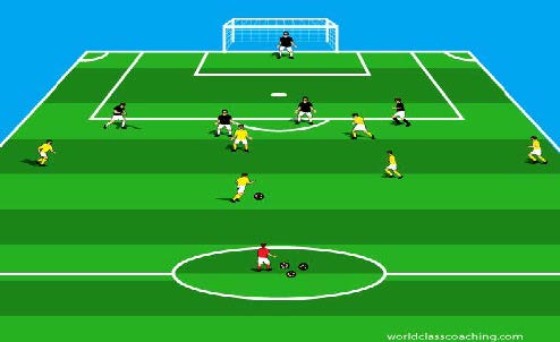
6 vs. 4 + Goalkeeper - 1/3 field
The attackers field four midfielders and two forwards. The defending group is composed of the goalkeeper and the four players along the back line. Restarts are played by a coach or resting player in the center circle. The attackers play to goal without restrictions. The defending group defend the goal. If the defenders win the ball, they play to the resting player at the restart point.
Coach:
• the defending group must move up field together, dressing their line with each pass by the attackers.
• The playing relationship between the goalkeeper and the back line. The goalkeeper must control the area behind the back line and communicate with the backs as to her intentions and also their priorities.
• The backs must learn to be patient. They are outnumbered, and their priority must be to delay and contain any attacking threat.
Training Session#13: Team defending
Introduction: This session is an extension of Session#12, which dealt with training the back line to play with the goalkeeper on defense. This functional session adds the midfield and then the front line to the defending group, allowing the coach to train the entire group together. The session also asks philosophical questions of the coach, helping her sort out defending roles and priorities for the team.
Goalkeeper, back line and midfielders defending - 2/3 field
Place the goalkeeper, back line and midfield group on the field, prepared to defend the goal. In the first phase, the coach walks around with the ball, aligning the team in various defending positions and situations, and clarifying critical roles.
Considerations:
• how many players will the team place in the midfield? If the team plays with three midfielders in a concentrated central triangle, the outside backs must work to understand how and when to step out to press the ball in the midfield. In a standard 4-midfielder set, the team must know whether and when they channel the ball to the inside or out on defense. If the team plays a 5-midfielder system, the ball is most often forced inside toward the defensive support of the central midfield grouping. The coach must think through and then discuss the relevant details with the players.
• how high will the defensive line play, and will they attempt to trap the opponent? If the team will play a high line, the midfielders (and forwards) must press the ball constantly in the middle third, so that the opponent cannot find space and time to set up runs and passes to defeat the high defensive line. Similarly, the goalkeeper must understand her duties as well if she is to adopt a high starting position to control the space behind the back line.
Progression:
• add an attacking group consisting of four defenders, four midfielders and two forwards. Also, add counter goals for the defending group to play to. The resulting game is 10 vs. 8 (assuming a defending block of 8 players from a 4-4-2) plus a goalkeeper. Play a standard scrimmage, with the attackers playing to goal and the defending group trying to score in the counter goals.
Coach:
• this is a very good environment for assuring that the defending block work together to squeeze the ball to desired spaces (central to a concentrated defensive unit or to the flanks to limit space and options).
• The other major coaching opportunity here is to work to control the space in front of the defense and behind the midfield group. The holding midfielder, in particular, must be aware of and connected to the center back(s) to assure that this critical space does not become a staging area for opponent attacks.
Team Defending - Full field
Add the appropriate front line players for the defending group and a goalkeeper for the attackers and play a full-field standard scrimmage.
Coach:
• the roles and responsibilities of the front line players. In a two front, the strikers press the opposing back line and try to channel the ball to one side of the field (or the middle), funneling opponent attacks into predictable and controllable space. In a 3-front, the pressure should be constant, with the flank attackers assuring that the opposing outside backs are not allowed to get involved in their team’s attacking and the center forward similarly stymieing efforts to play to either of the opposing center backs.
• Another consideration in this full-sided environment is the overall philosophy of the team with regard to pressure. Will the team play high pressure all over the field, or will the team confront the ball at a point (restraining line) on the field that allows the group to condense and frustrate opponent attacks?
• Situational defending. Another very good coaching tool in this environment is to work on situational defending. For instance, the team is down 0-1 with five minutes to play. How will the team play? The entire team must know that there must be considerable effort to pressure the ball and to keep the ball on the field as they try to find an equalizer. Conversely, what if the team leads 1-0 with five minutes left? They might still press, but they may also back off and condense their shape and be more willing to concede restarts to help kill off the game.


